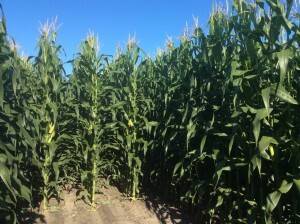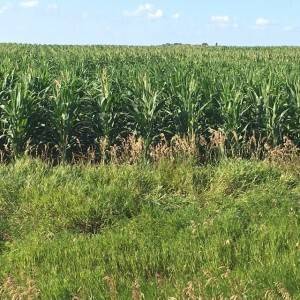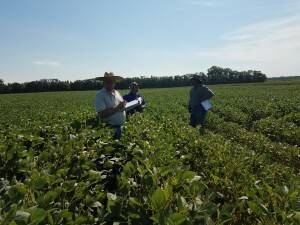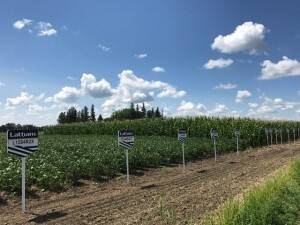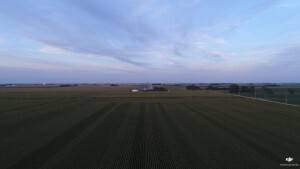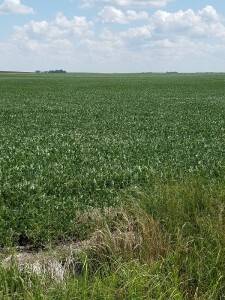Eastern North Dakota
Brian McNamee
Wow what a difference a week and 2.5 to 3 inches of rain makes. Phone calls went from customers calling asking about mycotoxins, poisonous nitrates and whether to bale or cut for silage to asking if they should now spend the extra money to push yield with all the lost fertility. Made the job way more enjoyable! I am amazed how much better these new corn hybrids and soybean varieties take adverse conditions.
Southeast North Dakota
Gary Geske
This photo was taken yesterday of our experimental conventional silage hybrid. It’s 11 feet tall and green.
Northeast South Dakota
James Keltgen
Leaves are puckering from lack of moisture in this Enlist demonstration plot. Most of the corn in my territory is done pollinating and is in the milk stage. Soybeans rea beginning to fill pods with little to no insect pressure so far. Some rain has fallen in drought-stricken areas, however, the damage has already been done to crops.
Southeast South Dakota
Ramie Coughlin
This week has been quiet in Southeast South Dakota. Recent rains and cooler temperatures have allowed the crops to do what they do best, produce. Some of those rains came very timely for many acres where others it was a bit to late already. This next week I look forward to visiting with many of you at Dakota Fest in Mitchell and learning about how your acres are looking.
Northern Minnesota
Ken Highness
Latham’s corn and soybean research plots help us evaluate products to bring into the product lineup. Latham Seed Product Manager Mark Grundmeier and Gary Geske, our Northern Product Specialist, are pictured here evaluating potential products on August 8 in Grand Forks, ND.
Southern Minnesota
Brandon Wendlandt
The Latham regional plot in Minnesota is signed and ready to go! You’re welcome to join us in Mountain Lake on Tuesday August 22, at 5 PM.
Southern Wisconsin
Greg Mair
Herbicide-resistant weeds becoming a growing problem in Wisconsin, so farmers and custom applicators have begun switching up herbicide programs. With the changes in herbicide programs, come changes in the sprayer tank cleaning procedure. A rinse or flush with water may have worked in the past for glyphosate, but it does not work for all herbicides. I’ve seen numerous soybean fields this year affected by improper tank cleaning when switching chemistry or fields, such as this one showing affects of ALS-inhibiting herbicide damage.
Northwest Iowa
Darin Chapman
Latham Hi‑Tech Seeds provides leadership to Upper Midwest farmers when choosing the right products for their specific geographies. We understand that precision agriculture plays a big part in helping us make these decisions. This is why we are doing research with our multi-hybrid planter to really micro-manage product placement.
South Central Minnesota & North Central Iowa
Cory Greiman
Aerial view of our dealer’s super strip plot near Garner, IA. It had some hail damage back on 7/10/17.
Southeast Minnesota & Northeast Iowa
Craig Haaland
Corn and soybean crops are looking really good throughout my territory. This picture of Latham’s 2358 Liberty soybeans was taken in Mitchell County.
The Mitchell County cornfield was planted corn-on-corn in late April to our popular LH 5509 SS RIB. Fungicide was applied to this field about 10 days ago, and it’s looking extremely good.
We could use a shot of rain this week, which is in the forecast. We also need to keep scouting fields to stay ahead of pest problems. At this point, I haven’t seen any aphids in soybean fields, but as we all know, they can move in quickly. Keep a watchful eye on them!
West North Central Iowa
Bart Peterson
Latham Hi‑Tech Seeds has a strong lineup of IRONCLAD soybeans, which offer the toughest defensive package. These soybeans are selected for “defense,” but they still pack a yield punch. Click here to see why IRONCLAD is your best defense against Iron Deficiency Chlorosis (IDC).
If you’re looking for a soybean with outstanding IDC tolerance, then L 1882 R2 is the product for you! This photo was taken of a field located 3 miles west of Gilmore City Iowa on Highway 3. Some areas in this field have a pH ranging from 8.0 to 8.3, but there’s no yellowing. High PH causes iron to be unavailable to plants, leading to stunted growth.
Eastern Iowa
Jerry Broders
Keep scouting soybean fields for aphids and Sudden Death Syndrome. Keep an eye on corn for diseases that can rob yield. Gray Leaf Spot starting to appear in some Eastern Iowa corn fields. Crop stage and amount of infection make a difference when making the decision to apply fungicide.
Central Iowa
Bryan Rohe
Western Iowa & Eastern Nebraska
Larry Krapfl
In spite of hot and dry weather there doesn’t appear to be any pollination issues!

